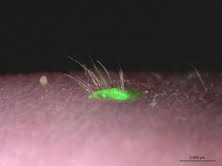Of all the numerous groundbreaking developments that have occurred in the hair loss cure research world during the past 3 years, Kythera Biopharmaceuticals and its Setipiprant prostaglandin D2 (PGD2) antagonist (inhibiting) product have easily been among the five most exciting developments to look forward to. For a better understanding of the link between male pattern baldness (MPB) and PGD2, this 2014 paper from the famous Dr. Luis Garza and Dr. Ashley Nieves is excellent reading as is this 2012 paper from Dr. Luis Garza, Dr. George Cotsarelis and others. In the simplest of terms, prostaglandin D2 levels are elevated in balding scalps, and inhibiting PGD2 could prevent baldness from progressing. In order to do this, you target the PGD2-GPR44 pathway (since PGD2 binds to the GPR44 receptor).
What excited me even more so than the research behind this subject matter is the following 2015 audio interview with Kythera founder and at-the-time CEO Keith Leonard. When I first heard it, I felt like he really knew what he was talking about, was sincere and was very excited about the “elegant” science (via research from Dr. Cotsarelis and his team at the University of Pennsylvania) behind this product. Unfortunately, it seems like Mr. Leonard is no longer with Kythera. Moreover, when I checked Kythera’s website today, the pages with a listing of board of directors and management were opening as blank placeholders. I would not read too much into Mr. Leonard’s departure, as the release of Setipiprant is still at least several years away in a best case scenario. To learn more about Kythera and Setipiprant, read my post from 2015 in its entirety.
Private Clinic Made PGD2 Inhibition Products to Treat Hair Loss
What made me think about this subject matter this week after several months of forgetting about it was an interesting new article published three days ago coming from India. Apparently a local clinic named “Hairline International Hair and Skin Clinic” is now offering PGD2 inhibitor therapy for hair loss. The article is full of typos, bad science and ads. Just like my take on the recent development from the Bahamas from a few weeks ago, my immediate reaction is that this Indian clinic’s product is likely to be totally ineffective and a sham. Nevertheless, this development is not surprising at all considering that so many hair loss forum members have been experimenting with similar homemade products for several years now (see links in next section). So perhaps such a product is not too difficult to manufacture/compound?
Are we about to see more hair loss clinics offer proprietary products that inhibit PGD2 or is this just a one-time thing that will spread to very few other places? A decade ago, very few hair loss clinics offered lasers or platelet-rich plasma therapy to treat hair loss, but now both are commonplace worldwide. Can PGD2 inhibition therapy follow a similar path? With PGD2 therapy, I do wonder how much the patent held by Kythera negatively impacts the chances of other competing proprietary products from hair loss clinics becoming popular and legal, especially in the US?
Homemade (“ghetto”) PGD2 Inhibition Products to Treat Hair Loss
There is a good chance that Setipiprant will significantly aid patients with androgenetic alopecia. The only problem is that clinical trials for Setipiprant will not be completed for several years. So not surprisingly, many people on hair loss forums are creating their own versions of Setipiprant/PGD2 inhibitors and testing them, or purchasing them from oftentimes sketchy vendors. The vast majority seem to have tested these “ghetto” products with no groundbreaking results to report. However, as is always the case with such experiments, a majority of people are probably not even remotely correct in getting correct ingredients, dosages, vehicles and more. In any case, I will leave you with some links to the said hair loss forum threads further below.
Also note that I plagiarized the “ghetto” term from “Swisstemples” who I have mentioned on this blog several times before. He has what seems to be an excellent page on his site regarding “The Postaglandin Protocol.” He also has a page on things to buy and use (where he uses the term “ghetto protocol” that includes some products to combat PGD2. I do not take any responsibility if you do what he suggests and get nasty side effects. I would never try any of this myself unless I had a really good chemist friend.
Note that people use various essentially synonymous terms for the products that they are trying in some of the below links, including “PGD2 receptor antagonist”, “PGD2 blocker”, “PGD2-GPR-44 receptor antagonist” and “CRTH2 receptor antagonist”.
— Update: Dr. Cotsarelis and Dr. Washenik are to present on this very subject matter on May 15th, 2016.
— An excellent poster from the 9th Congress for Hair Research last year (thanks “Hellouser”) can be found here –> “CRTH2/DP2 Antagonists Reverse Hair Growth Inhibition Caused by PGD2.” Main authors are Cotsarelis, Hsieh, Nace and Zheng.
— 51 page and growing HLT thread titled “dedicated Setipiprant log.” Seem to be overall negative results, but I have only read 3-4 of those pages.
— BTT thread on homemade PGD2 inhibitors.
— HLT thread on whether anyone is still on PGD2 blockers?
— HLH thread on OC000459, a CRTH2 antagonist. Also see Oxagen.
— Ramatroban (a PGD2 receptor antagonist) that many people seem to have purchased from iron-dragon. I have no idea about safety and legality issues.
— Note that Kane from China was offering his version of Setipiprant in the past, but I do not know the current status.
— Seems of interest regarding CRTH2.
— PGD2 Regimen — Cetirizine + Water.
— An interesting recent HLT thread on CRISPR type gene therapy to fix the three single nucleotide polymorphisms (SNPs) — rs545659, rs634681, and rs7167 — that have been found to be responsible for this PGD2 sensitivity.
— Resvertarol and PGD2? Not sure about this one.
— Quercetin and PGD2 video. Not sure about this one either, but many other hair loss forum posts on this subject.














